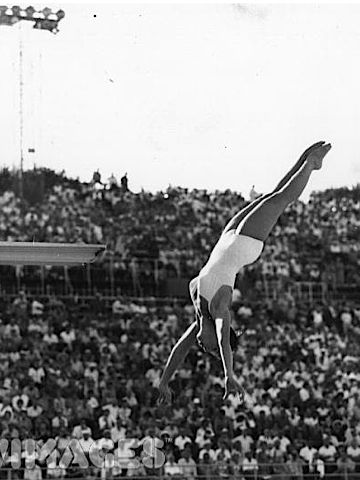
British athlete Elizabeth Ferris diving her way to the podium at the 1960 Olympics.

British athlete Elizabeth Ferris diving her way to the podium at the 1960 Olympics.
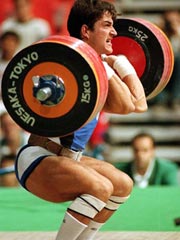 Mike Boyle's articles have a habit of encouraging a new viewpoint on things, and this article from September 2006 is no exception. Shortly afterwards I found myself thinking hard about the Front Squat; particularly the method of holding the bar.
Mike Boyle's articles have a habit of encouraging a new viewpoint on things, and this article from September 2006 is no exception. Shortly afterwards I found myself thinking hard about the Front Squat; particularly the method of holding the bar.
There are several ways to hold the bar for the Front Squat. If one method doesn't feel right, or your current flexibility or injury precludes it, try one of the others. It really is a great exercise.
Clean position
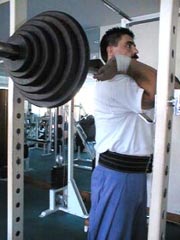 This is generally considered the optimum position - if you have the option, do it this way.
This is generally considered the optimum position - if you have the option, do it this way.
Think of it simply as the top of a Hang Clean (a reverse barbell curl if you like). It will get a lot easier with practice.
Arms crossed
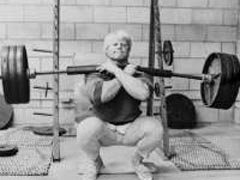 Another common method is to cross the arms over the bar, holding the left side with the right hand and vice versa. If the abovementioned Clean method is out of the question for you, try this.
Another common method is to cross the arms over the bar, holding the left side with the right hand and vice versa. If the abovementioned Clean method is out of the question for you, try this.
Note that the hands are only helping to stop the bar rolling about, rather than trying to support it.
Hands Clasped
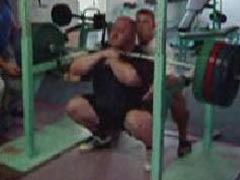 Whilst frowned upon by many purists, this technique is still used occasionally. Clasp your hands together and use them to push the bar onto your chest/front delts.
Whilst frowned upon by many purists, this technique is still used occasionally. Clasp your hands together and use them to push the bar onto your chest/front delts.
Log bar
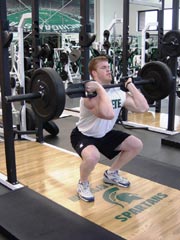 A much less common version (but intriguing nonetheless) is the Log Bar Front Squat. As you can see, a log bar prompts a vertical grip, which takes a similar amount of flexibility as the Clean grip.
A much less common version (but intriguing nonetheless) is the Log Bar Front Squat. As you can see, a log bar prompts a vertical grip, which takes a similar amount of flexibility as the Clean grip.
Straps
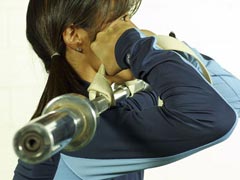 I noticed this yesterday in Mike Boyle's article Strong Athlete, Zero Injuries. It's an excellent idea, and well worth considering if you lack the flexibility required for the Clean.
I noticed this yesterday in Mike Boyle's article Strong Athlete, Zero Injuries. It's an excellent idea, and well worth considering if you lack the flexibility required for the Clean.
JV Askem had a similar idea many years ago with two pairs of pliers.
Stingray
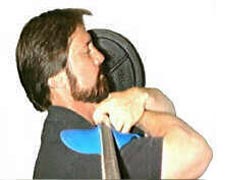 The Stringray device is designed to counter the basic deficiencies of the crossed arms approach. The two pads help keep the bar aligned and stable, allowing the widest possible grip to be used. The Stingray also lifts the bar slightly, keeping the weight over the front delts whilst keeping it away from your throat.
The Stringray device is designed to counter the basic deficiencies of the crossed arms approach. The two pads help keep the bar aligned and stable, allowing the widest possible grip to be used. The Stingray also lifts the bar slightly, keeping the weight over the front delts whilst keeping it away from your throat.
If the Clean position is out due to lack of flexibility, the Stingray is well worth considering.
Front Squat Harness
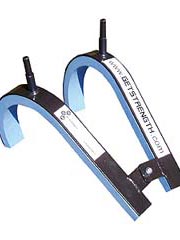 The Front Squat Harness performs a similar role to the Stingray (making the Front Squat a little more comfortable); although in a very different way. Here the bar is held - again with reasonable stability - slightly further forward, and is held using a narrow hammer grip.
The Front Squat Harness performs a similar role to the Stingray (making the Front Squat a little more comfortable); although in a very different way. Here the bar is held - again with reasonable stability - slightly further forward, and is held using a narrow hammer grip.
If it looks like a serious, large, strong device; it is. The original version was tested to over 600 lb, the current model exceeds that by a good margin.
Double kettlebells
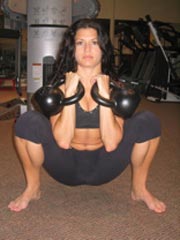 Got two kettlebells? Try this. Remember to Clean them one at a time.
Got two kettlebells? Try this. Remember to Clean them one at a time.
Goblet
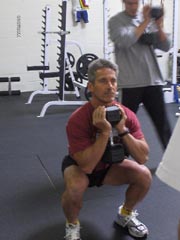 The Goblet Squat is often considered a separate exercise, however I've included it here for completeness. It can be performed either using a dumbbell as shown, or by grabbing a kettlebell 'by the horns'.
The Goblet Squat is often considered a separate exercise, however I've included it here for completeness. It can be performed either using a dumbbell as shown, or by grabbing a kettlebell 'by the horns'.
Hands free
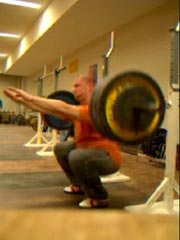 If none of the different holds shown above appeal, there's always the 'hands free' method (thanks Kris for the video). Unconventional to say the least.
If none of the different holds shown above appeal, there's always the 'hands free' method (thanks Kris for the video). Unconventional to say the least.
Here's Iranian weightlifter Hossein Rezazadeh front squatting 280kg / 617 lb during training. Not bad at all.
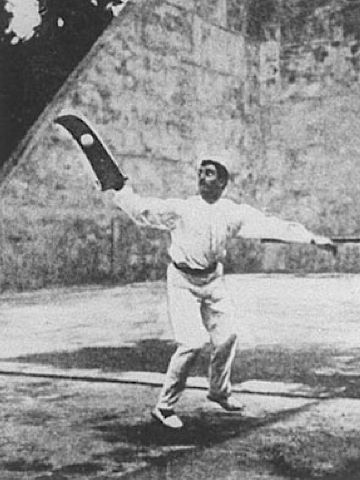
Pelota (Spanish for 'ball') only enjoyed a single Olympic outing : the 1900 Summer Olympic Games in Paris.
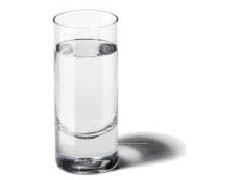 Most people seem to agree that drinking water is a good thing, and that it helps in many areas of health and fitness; from weight-loss to stress reduction. What seems to be less well defined - at least on the surface - is the advice to drink '8 glasses of water per day'.
Most people seem to agree that drinking water is a good thing, and that it helps in many areas of health and fitness; from weight-loss to stress reduction. What seems to be less well defined - at least on the surface - is the advice to drink '8 glasses of water per day'.
Where exactly did this advice come from? Back in April 2006, I did a little digging.
According to Valtin (i) the origin is probably the 1945 recommendation made by the Food and Nutrition Board of the US National Research Council. This stated :
A suitable allowance of water for adults is 2.5 liters daily in most instances. An ordinary standard for diverse persons is 1 milliliter for each calorie of food. Most of this quantity is contained in prepared foods.
The 2.5 litres was changed to 8 × 8 fluid ounce cups in later recommendations, but is otherwise unchanged.
A couple of things are worth noting about this information (which hasn't really changed in over 60 years). The first is the line 'An ordinary standard for diverse persons is 1 milliliter for each calorie of food'. This seems much more reasonable to me - tying water consumption to caloric intake - than simply drinking 2.5 litres of water. It would seem sensible that an athlete consuming 4,000 kCals per day would require a greater water consumption than one getting through 1,500 (for health reasons - we're not talking about preparing for bodybuilding competitions here).
The second is the part of the guideline which seems to have been overlooked in later versions - 'Most of this quantity is contained in prepared foods'. I wonder just how much diets have changed in 60 years.
Further observations - there appears to be a strong emphasis these days on 'pure' water consumption. Whilst I always make sure to drink a glass or two of water when also consuming alcohol, coffee or high-protein foods; the bulk of my non-food water consumption comes from green tea. This doesn't appear - at least in my case - to make any difference whatsoever.
i Valtin H. "Drink at least eight glasses of water a day." Really? Is there scientific evidence for "8×8"? Am J Physiol Regul Integr Comp Physiol 2002;283:R993-R1004
 Spring is definitely here, and it's the perfect time of year to go offline for a week and enjoy the Great Outdoors. Although there are no firm plans yet, that's exactly what I'll be doing. Until September 7, that is.
Spring is definitely here, and it's the perfect time of year to go offline for a week and enjoy the Great Outdoors. Although there are no firm plans yet, that's exactly what I'll be doing. Until September 7, that is.
In the meantime, there'll still be plenty happening on this site. A few personal favourites from the site's archives will be making a reappearance - together with some minor edits as necessary; there'll also be a couple of articles coming up from a guest author or three. I hope you enjoy them.
See you in a week.
 Finally, a HIT. Good condition, with box and a roll of film. Love it.
Finally, a HIT. Good condition, with box and a roll of film. Love it.
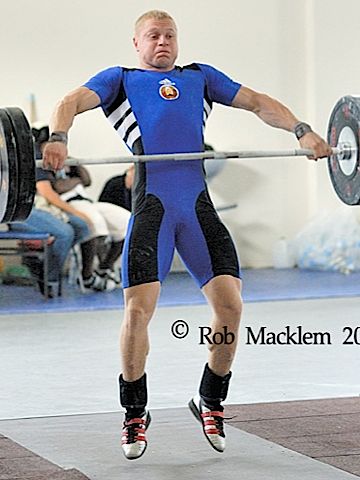 Another great week here at Straight to the Bar. A few highlights :
Another great week here at Straight to the Bar. A few highlights :

The incredible Lou Ferrigno. Photo via Bryan's Hulk Page.
 Via Elastic Waist : Cockeyed is putting together a very interesting table showing exactly what people look like at a given weight/height. Good stuff.
Via Elastic Waist : Cockeyed is putting together a very interesting table showing exactly what people look like at a given weight/height. Good stuff.